Modern warfare has become a deadly game of hide and seek. In recent decades, precision-guided weapons and advanced reconnaissance technologies have created a new rule on the battlefield: if you can be located you can be destroyed. Stealth technology emerged to cope with this new reality, offering a means of concealment from radar and other sensors, and thus an increased chance of survival, for combat aircraft, ships, and ground forces. I will explain the origins, workings, and prospects for military stealth technology and reveal some inconvenient truths about its utility.
The earliest methods of stealth in warfare were intended to avoid visual detection. Camouflage, tunneling, and nighttime maneuvers were often effective in conferring a battlefield advantage. Today radar, infrared, and acoustic detection technologies make concealment of military movement difficult, day or night. Enter stealth technology, which was introduced as a primary design element by the radar-evading U.S. F-117 attack fighter in 1983. Subsequent USAF combat aircraft, including the B-2 bomber and the F-22 and F-35 fighters, have incorporated progressively more refined stealth techniques. The stealth concept has also been applied to naval combatants and even to some army vehicles.
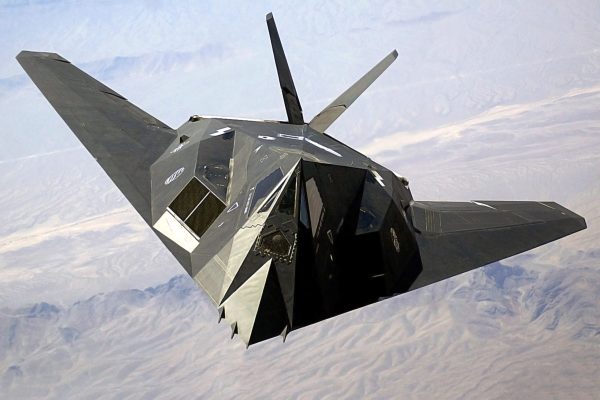
F117 Nighthawk stealthy tactical bomber
Aircraft Stealth
There are three design methods aircraft engineers have used to reduce the operational visibility of warplanes: geometry, coatings, and heat suppression. By carefully designing the shape of an aircraft to minimize radar reflections, the effectiveness of radar tracking can be reduced considerably. Coating the skin of the plane with radar-absorbing material (RAM) further reduces the radar “signature,” and suppressing the emission of heat from the plane’s engines, lowers the visibility of the aircraft in the infrared spectrum. Even the missiles launched from stealthy aircraft have been designed to be stealthy, further adding to the potency of these weapons. All these measures increase the cost of an aircraft, both initially and for maintenance over its operational life.
Naval Stealth
The introduction of submarine warfare was the first, and arguably most effective, implementation of stealth in naval warfare. Missile submarines are the backbone of the U.S. strategic nuclear deterrent, and attack submarines are the deadliest threat to surface ships. Radar is not a threat to submerged submarines, but sonar is used to detect them. Thus, great efforts have been made to reduce the acoustic signatures of subs, making them as quiet as possible. Surface ships have been redesigned to apply the methods of radar signature reduction developed for stealthy aircraft. The newest surface combatants look quite different from their predecessors, with smooth, uncluttered surfaces covered by radar-absorbing coatings. While these methods cannot be applied to U.S. aircraft carriers, many of the aircraft that fly from them are naval versions of the stealthy F-35.
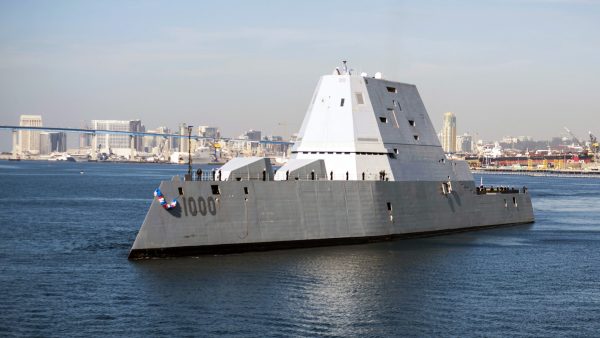
USS Zumwalt – Stealth at sea
Army Stealth
While the stealth technology implementation efforts of the U.S. Army are not as advanced as those of the other services, efforts are under way to reduce the vulnerability of Army vehicles and personnel. Newer Army attack helicopters incorporate some stealth features, and the latest developments in vehicle and soldier camouflage include measures to reduce the thermal signature of ground forces.
The Limits of Stealth
Stealth technology is a genuine advance in the art of weaponry, but it is not a guarantee of military dominance. The history of warfare is one of measures and countermeasures, and stealth technology is no exception. The following issues will limit the impact of stealth on warfare.
Competition
Although the U.S. took an early lead in developing stealthy aircraft, fielding two fighters (F-22 and F-35) and two bombers (F-117 and B1) between 1981 and 2006, The other superpowers followed suit: Russia with the SU-57 fighter in 2010 and China with the J-20 fighter in 2011 and the J-35 in 2021. Production of the U.S. B-21 has just begun, but the newly announced U.S. F-47 fighter is only in early development, while China’s new J-36 and J-50 prototypes have already been sighted in the air. Technical details of all of these planes are classified, but it is clear that the U.S. no longer enjoys a monopoly in stealth aircraft
Cost
Stealth is expensive. The following table show the comparative costs of U.S. stealth aircraft compared to their non-stealthy equivalents. Note that the cost differential is not limited to the initial procurement. The maintenance costs are also higher because of their greater complexity and the need to maintain the stealth coatings of the aircraft.
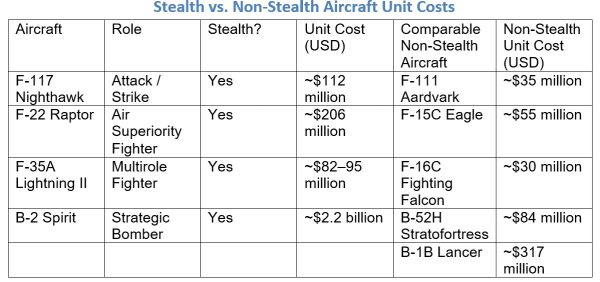
The cost factor is the reason why it would be infeasible to redesign military transport, refueling, and surveillance aircraft to make them stealthy.
Detection Advances
As the U.S. deployed stealthy warplanes, other major nations developed and fielded improved radar systems, such as the Russian Nebo-M, Voronezh, and P-18, which use VLF and UHF frequencies that can detect stealthy aircraft. Even regional powers, like Iran, have deployed new radars with improved detection capabilities to counter stealth aircraft. Another counter-stealth method is networking radars to locate such aircraft by scanning from multiple directions. Early research on photonic radar, which relies on laser light rather than radio frequency waves, indicates a promising potential to detect and track stealthy aircraft.
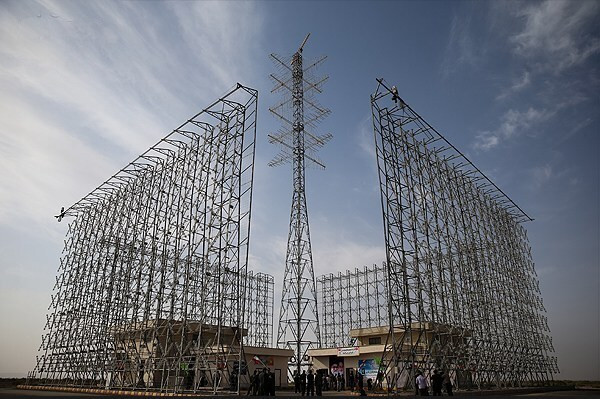
Iranian Ghadir anti-stealth radar
Logistical Vulnerability
While stealthy planes may be less vulnerable in the air, they are highly vulnerable on the ground, and they are reliant on the planes, ships, and bases that supply them with fuel and weapons. Of particular concern are the tanker aircraft that are essential to long-distance air power projection. The Air Force currently operates approximately 600 aerial refueling planes, and none of them are stealthy. Their destruction would cripple the ability of stealthy aircraft to conduct long-range campaigns. U.S. transport and airborne radar aircraft also lack stealth characteristics, and thus would be easy prey in a future war. Finally, the air bases from which stealthy aircraft operate cannot be concealed, and they would be high priority targets for missile attack.
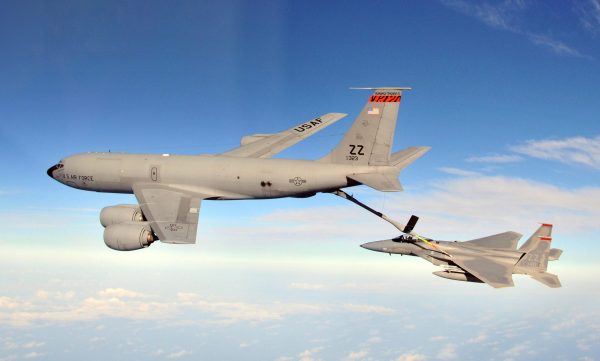
KC135 aerial refueling tanker – zero stealth
The Future of Stealth
The simplest way to overcome the cost and detection problems limiting the efficacy of stealth technology is to reduce the size of weapons. The crucial metric of stealth in the radar spectrum is the Radar Cross Section (RCS), and this is roughly proportional to the size of the aircraft/vessel/vehicle. Similarly, visual and infrared signatures diminish with size. Thus, the easiest and cheapest way to achieve improved stealth is to replace manned weapons with smaller and cheaper robotic systems. Providing superior stealth characteristics at lower cost, is yet another factor which will drive the displacement of manned aircraft, ships, and ground vehicles by their drone equivalents. However, perverse vendor incentives and military institutional inertia will likely lead to further costly and troubled manned stealth aircraft programs, such as the B-21 bomber and the newly-announced F-47 development project.
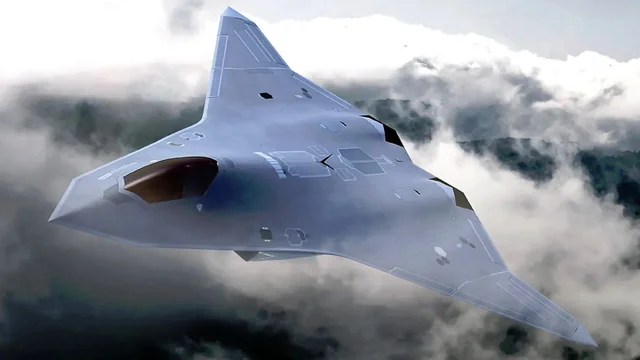
Depiction of U.S. F-47 sixth generation stealth fighter
Conclusion
Stealth technology, while functionally appealing to the military, is a classic example of arms racing, in which new developments spur competitive and counteractive efforts in other nations. Stealth is unlikely to be decisive in future wars because it is irrelevant in asymmetric conflicts, such as the current U.S. campaign against the Houthis in Yemen, and it will likely face comparably protected planes, ships, and troops in a war with a peer adversary. In a large-scale conflict, stealth may protect some planes and ships, but it cannot shield the vulnerable bases and logistical units that are essential to successful military operations.
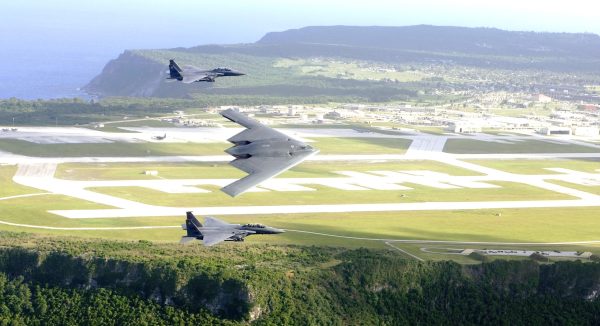
Andersen Air Force Base, Guam – Prime target?
Military considerations aside, it may be said that the greatest triumph of stealth was in the domain of U.S. defense politics. At the start of the F-35 program, clever lobbying by contractors and the Pentagon reduced the acceptance testing rigor for this vast undertaking. This allowed the troubled project to figuratively fly under the radar of effective oversight. When the Defense department committed to low-rate production of the F-35 before the completion of normal testing in 2001, the result was building many aircraft that would later require costly upgrades. The F-35 has still not met all its testing requirements. Undeterred by the problems of the F-35, in the 2016 National Defense Authorization Act, Congress established the Middle Tier Acquisition pathway (MTA), which substantially reduced testing requirements for high-priority weapons projects. Thus, whatever the outcome of future armed conflicts, stealth in weapons engineering and in lobbying tactics will continue to bring growing income to arms makers, the biggest winners in arms racing.


Not quite 25 years ago, I was sitting with my team for the midday meal at a canteen table; somehow the discussion moved to the topic of stealth aircraft. The USA had just reached some important milestone regarding the F-22, and we were duly impressed by the publicized capabilities of the aircraft.
The two colleagues who had worked at British Aerospace turned to each other with a quizzical look — the sort of look expressing “What? Don’t they know?” — then told us that stealthiness does not really work, because:
1) those magic coatings are a bitch to apply, and if they are damaged, there goes the stealthiness;
2) even with a perfect coating, if you fly the aircraft in the rain, there goes the stealthiness;
3) all the big guys have radars that can detect stealth aircraft even with a pristine coating and in nice weather.
Technology has probably evolved to address some of those issues, but I later learned about the stealth F-117 being shot down and the second F-117 being hopelessly damaged by 1960s-1970s era Serbian radar-controlled anti-aircraft missiles. As a result of all of this, I am unconvinced that the cost and complexity of stealthiness are actually justified. But hey, all those military aircraft engineers seem to like it.
>But hey, all those military aircraft engineers seem to like it.
And the shareholders of defense companies. and the board of directors. And especially the CEOs with the fat performance options and bonuses…
Doesn’t matter if stealth tech works or not.
>”if they are damaged, there goes the stealthiness”
What would you say about the rust on those carrier-F-35s? POGO I believe had already reported on this 2022. Quoting USAF that the rust would not impede with stealth. Statement didn´t sound convincing. But I am not the engineer. And how are you gonna prove that? It´s all classified unless you steal one of them planes and test yourself…
The lower frequency radars that can ‘detect’ stealth cannot pinpoint the location accurately enough to produce a missile lock. They can tell that something is in the air within 10 miles of its location, but cannot shoot it down.
Regarding the shooting down of those F117s. Stealth doesn’t mean invisible just that the effective range of the radar is less. If you fly your plane through that effective range (as happened in Serbia) you get detected. Even then the crew of the SAM installation had to override the system and do a manual launch since the system IIRC classed the F117 as a swarm of birds.
So stealth can be worth it if you can plan your routes around fixed radar installations, have real-time satellite tracking for mobile installations (plus the room to maneuver around them), and do not have to refuel. Have those then you can drop bombs pretty far behind enemy lines.
The real reason why it is stealth is not worth it is that you can do the same with a cruise missile and these days drones
Ground on plane was the game when it started, first gen had a advantage in both ground and air. Since then ground to air has advanced and only air to air has some meaning.
My understanding is that the Area 51 lawsuit (the real thing, Kasza v. Browner, litigated by Jonathan Turley among others (I think),on behalf of civilian air force employees at thr site who wound up with rare cancers and other nasty illnesses, was mainly over how toxic fhs radar absorbent materials (the paint and duch) are. The suit was dismissed on national security grounds, though, IIRC (or, was it that they couldn’t proceed to discovery because the gov’t claimed everything related to these materials were secret so the plaintiffs couldn’t make their case…)
Yes, Area 51 (Groom Lake) was the top secret location where the F-117 Stealth Fighter was initially stationed so that the test flights over the vast Nevada (mostly unpopulated) landscape would be less likely to be detected. Much of the air space over Nevada is restricted, as well. (I was flying in a Nevada State KingAir Baron in the 80’s when a F-16 from Creech AFB intercepted us for flying too close to Area 51.
Fortunately the Baron pilot was a major in the NV Air Guard and former USAF jet pilot, and understood the near aggression from the F-16 and made a strong bank turn away from the Groom Lake direction. Wild experience! Told not to talk about it by State superiors. It’s been some 40 years, so I think I’m safe now ;)
Cool story.
(Like that John Helmer one last week.
Talking about CIA picking out Australia´s Governor-General for the PM. He too kept quiet about this for more than 40 years.)
The F35 was designed to be very expensive to build, very expensive to maintain and with parts built in 44 States impossible to cancel, because Jawbs.
It was not built to fight.
At the end of WW2 the USA had 188 Generals and 6,000,000 under arms, today the USA has 653 Generals and 175,000 under arms.
It, also, is not built to fight, it is built to provide for the welfare of Generals.
Purpose-built to be a self-licking ice cream cone!
F-35 was built to fight in Wrestlemania, and so is Trump.
“At the end of WW2 the USA had 188 Generals and 6,000,000 under arms, today the USA has 653 Generals and 175,000 under arms.”
These numbers are completely wrong. All of them.
Those aerial refueling planes are vulnerable to attack but to really screw up operations, the ones to take down are the AWACS which help control the battle by directing friendly aircraft to targets. Take them out and you throw a spanner into the battle space management plan-
https://en.wikipedia.org/wiki/Airborne_early_warning_and_control
Universalist humanity and all life on earth must prevail. Overthrow militarism.
Fully agree. Yet, the more I learn about this shit the less imagination I have left for that overthrowing to really ever take place in a meaningful way.
But hey, in Germany they stopped the vaccine mandate in parliament totally unexpectedly. That was a pleasant surprise. They won´t ever get back the money from Pfizer. But at least the public talks about it. So never understimate people.
And I know there is much grassroots organizing taking place around those nuclear silo locations in the US.
p.s. Did you know that LaForge guy from US Nukewatch had spent 2 months in a German prison in Hamburg for protesting at the German nuclear site of Büchel 2 years ago. I then thought about visiting him in prison or writing to him but of course I got caught up with other things (plus I don´t live in Hamburg).
Either you organize resistance and you´re in it. Or you don´t. Fighting the system for real is a full-time job and a very serious undertaking.
Thank AG, like minds must save us. I reach out with desire, but feebly.
Resistance in Germany is tough going. Outgoing Social Democratic interior minister Nancy Faeser just got a journalist sentenced to 7 months probation for posting a meme.
https://www.eugyppius.com/p/german-journalist-sentenced-to-seven
The political establishment — the anti-AfD cartel of parties — say the AfD is fascist, but they’re doing a pretty good impression of the F-word themselves. Another example is how police, lawfare, firings, and deportations are being used to intimidate people away from voicing any but the mildest criticism of Israel, even by UN human-rights rapporteur Francesca Albanese.
It´s a fucking catastrophe.
What makes me personally completely mad – the entire German elite (media, academia, the “politically informed”) actually agree with the official Gaza/Israel narrative. That just drives me nuts.
I don´t even wanna know how many of those hundreds of thousands who were protesting against “the Right” in 2023 and last year would also protest against Israel.
For those who do not know:
A journalist was sentenced after posting a picture of the German Minister of the Interior holding a sign saying: “I hate freedom of speech”.
German judiciary is a huge problem due to the intellectual incompetence of its judges.
we’re on the cusp of (whether satellites or very high altitude drones, balloons) of “stealth” planes trackable by a “constellation of things in the sky” via their contrails and/or heat from far distances.
from my armchair, the future will skew very severely to the “quantity has its own quality”-end of the spectrum.
The US military has a long history of giving weather briefings to avoid contrails. Also, most military airplanes have mirrors, periscopes, and other ways to observe if contrails are being formed.
There were some studies of commercial airliners avoiding contrail developing altitudes but the airways are too congested to allow that flexibility.
Witness the emergence of military drone warfare in the Russo Ukranian Special Military Operation. I read that the ‘takfiri’ fighters extensively used drones against the Syrian Army during the collapse of that country.
(Can we even speak of a Syria as a functioning nation state anymore? I think not. Like Cyprus, it might devolve into spheres of interest: the Turks up north, with the Kurds to the east and the Alawites on the coast and Eretz Ysrael holding a sanjak to the south.
The real possibilities inherent in small military drones is their very size and ease of concealment. Perfect for insurgencies and revolts.
Stay safe. Keep watching the skies!
I’ve heard that earth observation satelites can track submarines by looking at the way they mix up different layers of seawater, although, it occurs to me that this might be countered by submarines watching their diving depths (but I have no idea about the sciences behind this, so…)
Given the present Pentagon acquisition model and the costs it produces, quantity ain’t gonna be achievable. Hence the claimed wunderwaffen qualities of everything US-made – the publix have to rest assured that we have the bestest and lethalest toys for our boys playing at World Police.
“Stealth” is a bit of a proxy for a whole host of information-age technologies in modern weapon systems. A lot has to do with with radar, modern advanced electronically-scanned array radars, the computing power to make sense of the returns, and then the jamming systems to confuse the returns of the enemy. Also important is information sharing, the web of data-links that allow different aircraft, missiles, and surface units to share targeting information with each other. These electronics, along with the vicissitudes of modern management, are what is driving up the cost of these aircraft, not just the funky shapes and RAM coatings.
The scary thing is that whether these systems work or not boils down to how buggy the underlying software is, and every big piece of software seems to be full of bugs these days.
In terms of politics, stealth aircraft are generally invisible to high-frequency targeting radars beyond 10-20 miles, but low-frequency arrays, like those used to detect over the horizon ballistic missile launches, can vaguely detect stealth aircraft at long range. Actually downing a stealth aircraft requires vectoring in a fighter or SAM to within a few miles of the aircraft, where radar and infra-red/optical systems can target it. There were rumors that an Israeli strike on Iran last year was aborted when it became obvious that the Iranians were tracking the Israeli F-35’s and preparing a defense. The B-2’s being moved to the region now would probably used long-range stealth cruise missiles and a different attack vector to avoid a similar response.
The F-117’s shot down over Serbia were being stupid, flying the same route every night on their bombing runs. A crafty Serbian SA-2 operator managed to light up the planes just as they opened their bomb-bay doors, which provided enough radar return for the old missiles to lock-on.
F-47? Golly, do you suppose that 47 is a posterior osculation wafted to a certain person often in DC and frequently on the golf courser? Couldn’t be. If the development of said F-47 follows the usual path the “certain person” will not be around to enjoy it.
Stealth followed by anti-stealth countered by anti-anti-stealth and so on ad infinitum. Better go after the AWACS, tankers, carriers and land bases.
This article gets a few key things wrong:
1) No, the best way to reduce RCS isn’t to shrink the physical vehicle. This misunderstands the entire basis of stealth technology, which is to use a combination of stealth shaping and materials to reduce the RCS of a heavy fighter or bomber to that of a ball bearing or seagull.
2) No, detecting a stealth aircraft doesn’t mean you can shoot it down. Acquiring a weapons-grade lock is not the same thing as detection. None of these VLF/UHF radars can generate a firing solution for a SAM.
3) No, stealth is not irrelevant in asymmetric conflicts. The author mentions the conflict with the Houthis – well, the Houthis have shot down 4 MQ-9 Reaper drones. Physically small, but not stealthy aircraft per se.
The best criticism the author makes is the logistical vulnerability of tankers – it doesn’t matter how stealthy your strike fighters are if their tanker is shot down. Unfortunately the USAF has been reluctant to commit to a stealthy tanker program, effectively hobbling the striking power of the relatively short-ranged F-22/F-35 force against an adversary that can destroy the decidedly non-stealthy USAF tankers supporting these aircraft.
MQ-9 Reaper physically small:
Length: 36 ft 1 in (11 m)
Wingspan: 65 ft 7 in (20 m)
For comparison, regular size aircraft, A-10:
Length: 53 ft 4 in (16.26 m)
Wingspan: 57 ft 6 in (17.53 m)
(numbers copy-pasted from Wikipedia)
Speaking of Wikipedia, even there there is more than 4 Reapers shot by Houthis mentioned.
USAF being reluctant to commit to a stealthy tanker program is probably because even US money printing machine has its limitations. It is indeed unfortunate for the shareholders of the company that would get the contract, and also for those that would want to see the Empire go down faster (like myself). I say, pump few gazillion bucks more into B-21 program, in order to give B-21s capability to refuel others B-21s. A self-licking ice cream cone.